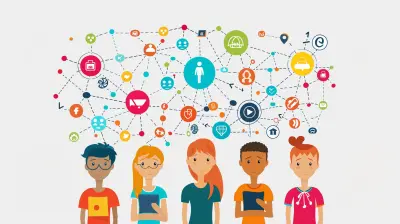Navigating Cross-Generational Communication in the Workplace
20 May 2025
Ever feel like you're translating a foreign language when talking to your coworkers? You’re not alone. The modern workplace is a melting pot of different generations, each with its own communication style, preferences, and pet peeves. Boomers might prefer a phone call, Millennials love their emails, while Gen Z would rather send a DM or emoji-filled Slack message.
So, how do we bridge the gap and make office communication less of a battlefield? Buckle up! We’re diving into the art (and science) of navigating cross-generational communication in the workplace.

Understanding the Generational Divide
Before we attempt to decode each other's preferences, let’s meet the key players:Baby Boomers (Born 1946-1964)
The OGs of the corporate world. They value face-to-face meetings, hierarchical structures, and formal communication. If you email them, expect a full paragraph (no emojis, please).Generation X (Born 1965-1980)
The middle-child generation. They appreciate autonomy and efficiency. They’re comfortable with both phone calls and emails but don’t expect them to hover over your messages 24/7.Millennials (Born 1981-1996)
The "Why send an email when a meme will do?" generation. They prefer collaboration, digital communication, and flexible work environments. If they send you a gif, it’s probably their way of saying, “Great job!”Generation Z (Born 1997-2012)
The digital natives. Text over talk, Slack over email. If you're sending them a wordy email, prepare for them to TL;DR it. They love quick, concise, and informal communication.
The Common Communication Crash Points
Each generation has its quirks, but where do things usually go south?1. Communication Preferences (Emails vs. Texts vs. Calls)
Ever called a Gen Z team member only to have them text back, “What’s up?” instead of answering? Or emailed a Boomer and gotten a detailed essay in response? Yeah, that’s the generational divide at work.The Fix: Instead of enforcing one style, create flexible communication norms. Maybe use emails for formal communication, instant messaging for quick updates, and meetings for important discussions.
2. Feedback Style (Tough Love vs. Positive Reinforcement)
Boomers and Gen X folks were raised in a world where "constructive criticism" meant "direct and unfiltered feedback." On the flip side, Millennials and Gen Z thrive on positive reinforcement and encouragement. A simple “Good job” can go a long way.The Fix: Balance is key. Offer feedback in a way that’s both constructive and encouraging. Sandwich criticism between praise—think of it as the feedback burger: Start with a positive, give the critique, and end on an encouraging note.
3. Work Ethic & Expectations (9-to-5 vs. Flexibility)
Boomers and Gen X were raised on "butts in seats" = Productivity. Millennials and Gen Z swear by results over hours worked. If they can finish a project in three hours instead of eight, why sit at a desk bored?The Fix: Instead of arguing over which approach is "right," focus on outcomes, not schedules. If the work gets done well and on time, does it really matter if someone finishes it from a coffee shop instead of a cubicle?
4. Use of Technology (Emails vs. Slack vs. TikTok?!)
Ever watched a Boomer struggle to share their screen while a Gen Z colleague whizzes through five different apps at once? The tech gap can be real.The Fix: Bring everyone up to speed with tech training sessions. At the same time, respect that not everyone needs to be a Slack ninja to contribute meaningfully to work. 
How to Bridge the Generational Gap
Now that we've identified the trouble spots, let’s discuss how we can actually get along.1. Embrace a Multi-Channel Communication Strategy
There's no one-size-fits-all approach to workplace communication, so why force it? Use different platforms for different needs:- Emails for formal updates
- Instant messaging for quick questions
- Meetings for brainstorming
- Phone calls for urgent matters
This way, everyone gets their preferred method somewhere in the mix.
2. Encourage Cross-Generational Mentorship
Boomers and Gen X have experience and wisdom. Millennials and Gen Z bring innovation and adaptability. Why not pair them up?Reverse mentorship programs allow younger employees to teach tech and new trends, while older employees pass on leadership and industry insights. A win-win!
3. Adopt a “Respect the Differences” Mentality
Instead of rolling your eyes at a Boomer’s long-winded email or a Gen Z’s one-word Slack messages, try understanding where they’re coming from. Different doesn’t mean wrong—it just means different.4. Set Clear Expectations
If your team agrees that urgent matters require a phone call, make that a rule. If emails should be reserved for formal communication, set that boundary. Expectations prevent frustration.5. Use Humor to Diffuse Tension
Humor is the universal language. A well-placed joke about generational quirks can lighten the mood and create common ground. After all, who doesn’t love a good "back in my day" joke?
The Future of Workplace Communication
As Gen Alpha (yes, that’s the next group) enters the workforce, new challenges will arise. The key to future-proofing workplace communication? Adaptability.Technology will continue evolving, and so will communication preferences. Companies that thrive will be those that remain open to change and willing to meet people where they are.
In the end, it’s all about understanding, respect, and a little compromise. Whether you’re a Boomer, Gen X, Millennial, or Gen Z, we’re all on the same team. And if nothing else… at least we can all agree that replying to an email with “per my last email” is just passive-aggressive magic at its finest.
Final Thought
At the end of the day, learning to communicate across generations isn't just about avoiding misunderstandings—it's about creating a more inclusive, productive, and harmonious workplace. So, the next time you're baffled by a colleague’s messaging style, take a breath, adjust your approach, and remember: we’re all just trying to get our work done… preferably without a million back-and-forth emails.all images in this post were generated using AI tools
Category:
Communication SkillsAuthor:

Zoe McKay
Discussion
rate this article
3 comments
McDonald
Thank you for this insightful article! Effective cross-generational communication is crucial in today's diverse workplaces. Your practical tips will surely help foster understanding and collaboration among team members of all ages.
June 15, 2025 at 4:41 AM

Zoe McKay
Thank you for your kind words! I'm glad you found the article helpful in promoting effective communication across generations.
Zephyrine Walker
Effective cross-generational communication enhances collaboration, fosters understanding, and drives innovation, making it essential for a successful workplace.
May 28, 2025 at 3:55 AM

Zoe McKay
Thank you for your insightful comment! I completely agree that effective cross-generational communication is key to fostering a collaborative and innovative workplace.
Jennifer McQuillen
Effective cross-generational communication fosters collaboration, leveraging diverse perspectives to enhance workplace dynamics and innovation.
May 26, 2025 at 10:36 AM

Zoe McKay
Thank you! I completely agree—cross-generational communication is essential for creating a collaborative and innovative work environment.



